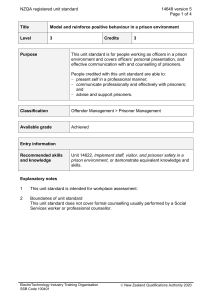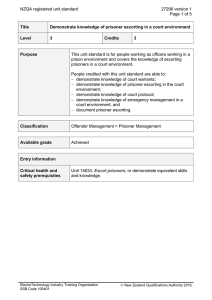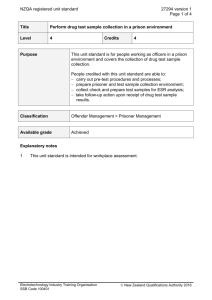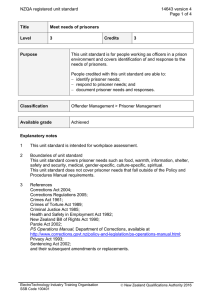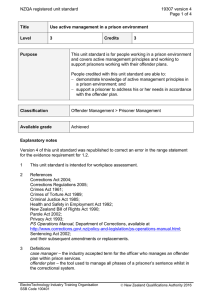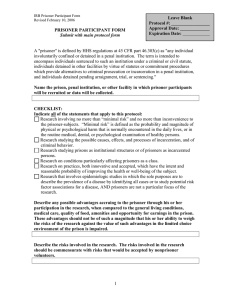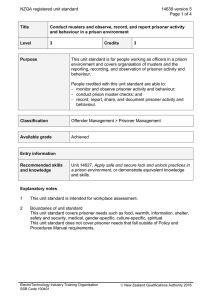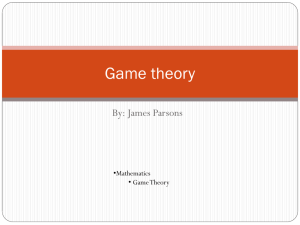NZQA registered unit standard 27292 version 1 Page 1 of 4
advertisement
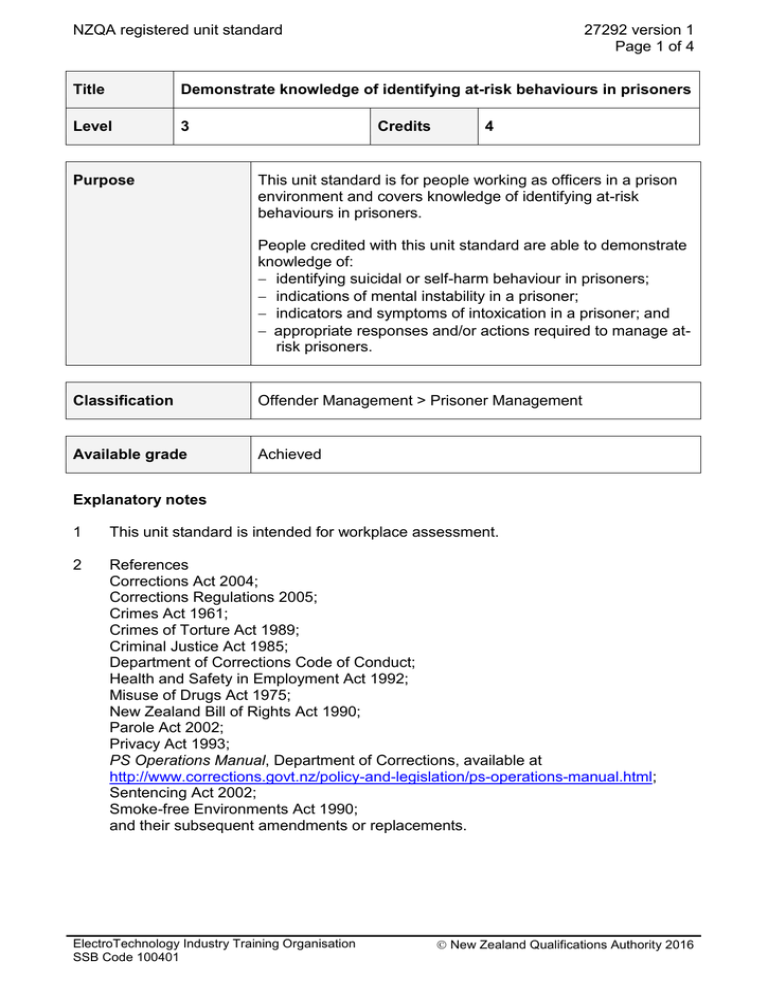
NZQA registered unit standard 27292 version 1 Page 1 of 4 Title Demonstrate knowledge of identifying at-risk behaviours in prisoners Level 3 Purpose Credits 4 This unit standard is for people working as officers in a prison environment and covers knowledge of identifying at-risk behaviours in prisoners. People credited with this unit standard are able to demonstrate knowledge of: identifying suicidal or self-harm behaviour in prisoners; indications of mental instability in a prisoner; indicators and symptoms of intoxication in a prisoner; and appropriate responses and/or actions required to manage atrisk prisoners. Classification Offender Management > Prisoner Management Available grade Achieved Explanatory notes 1 This unit standard is intended for workplace assessment. 2 References Corrections Act 2004; Corrections Regulations 2005; Crimes Act 1961; Crimes of Torture Act 1989; Criminal Justice Act 1985; Department of Corrections Code of Conduct; Health and Safety in Employment Act 1992; Misuse of Drugs Act 1975; New Zealand Bill of Rights Act 1990; Parole Act 2002; Privacy Act 1993; PS Operations Manual, Department of Corrections, available at http://www.corrections.govt.nz/policy-and-legislation/ps-operations-manual.html; Sentencing Act 2002; Smoke-free Environments Act 1990; and their subsequent amendments or replacements. ElectroTechnology Industry Training Organisation SSB Code 100401 New Zealand Qualifications Authority 2016 NZQA registered unit standard 27292 version 1 Page 2 of 4 3 Definitions Licit drugs – may include restricted drugs and include medication. Illicit drugs – drugs forbidden by law. Includes but is not limited to – cannabis, methamphetamine. Other personnel/individuals – may include but are not limited to managers, other officers, medical staff, cultural advisors, chaplains. NARA – new arrival risk assessments. Prison environment – any area, within a prison site or external to a prison site where prisoners are held, such as a cell block, within the prison perimeter, on a prison farm, in a vehicle transporting prisoners. 4 Assessment range a Performance of the outcomes of this unit standard must meet all the principles of behaviour and criteria as detailed in the Prison Services Operations Manual (PSOM), Department of Corrections (available at http://www.corrections.govt.nz/policy-and-legislation/ps-operations-manual.html), the Department of Corrections Code of Conduct, other documented national policies and procedures, and prison-specific procedures. b The range statements in this unit standard must be applied according to prisonspecific equipment, procedures, and processes. Outcomes and evidence requirements Outcome 1 Demonstrate knowledge of identifying suicidal or self-harm behaviour in prisoners. Evidence requirements 1.1 Describe factors that can influence a prisoner to attempt suicide or self-harm. Range 1.2 factors may include but are not limited to – drug and alcohol withdrawal, new sentences, first time prisoner, type of offense, parole, age, misconduct charges, medical conditions, family or other external news or information received; evidence of three is required. Describe indications that a prisoner may be at risk of suicide or self-harm. Range indications may include but are not limited to – behavioural changes, emotional signs of distress, information from other prisoners, giving possessions away, history, alerts, staff observations, information from other individuals; evidence of three is required. Outcome 2 Demonstrate knowledge of indications of mental instability in a prisoner. Evidence requirements 2.1 Describe factors that may influence mental instability in a prisoner. ElectroTechnology Industry Training Organisation SSB Code 100401 New Zealand Qualifications Authority 2016 NZQA registered unit standard 27292 version 1 Page 3 of 4 2.2 Describe behavioural indications that a prisoner may be mentally unstable. 2.3 Describe factors influencing a prisoner’s past offending and behaviour. Range prisoner’s background and personal history, psychological factors, criminal factors, social factors. Outcome 3 Demonstrate knowledge of indicators and symptoms of intoxication in a prisoner. Evidence requirements 3.1 Describe indications of intoxication in a prisoner. Range 3.2 physical indicators, mental indicators. Describe symptoms of intoxication in a prisoner. Range alcohol intoxication and two other types of intoxication; symptoms may include but are not limited to – slurred speech, red eyes, dilated pupils, ‘pinpoint’ pupils, extreme drowsiness, slowed responses, agitated, extreme aggressive behaviour. Outcome 4 Demonstrate knowledge of appropriate responses and/or actions required to manage atrisk prisoners. Range suicide risk, mental instability, alcohol and/or illicit drug intoxication, possession of excessive amounts of licit drugs. Evidence requirements 4.1 Describe responses to a prisoner exhibiting at-risk behaviour. Range responses are in terms of preservation of life as main consideration. 4.2 Identify other personnel and/or individuals who may need to be consulted and/or involved. 4.3 Describe documentation and reporting requirements. Range documentation may include but is not limited to – NARA, incident reports, file notes; evidence of three is required. ElectroTechnology Industry Training Organisation SSB Code 100401 New Zealand Qualifications Authority 2016 NZQA registered unit standard Planned review date 27292 version 1 Page 4 of 4 31 December 2016 Status information and last date for assessment for superseded versions Process Version Date Last Date for Assessment Registration 1 20 May 2011 N/A Consent and Moderation Requirements (CMR) reference 0003 This CMR can be accessed at http://www.nzqa.govt.nz/framework/search/index.do. Please note Providers must be granted consent to assess against standards (accredited) by NZQA, or an inter-institutional body with delegated authority for quality assurance, before they can report credits from assessment against unit standards or deliver courses of study leading to that assessment. Industry Training Organisations must be granted consent to assess against standards by NZQA before they can register credits from assessment against unit standards. Providers and Industry Training Organisations, which have been granted consent and which are assessing against unit standards must engage with the moderation system that applies to those standards. Consent requirements and an outline of the moderation system that applies to this standard are outlined in the Accreditation and Moderation Action Plan (AMAP). The AMAP also includes useful information about special requirements for organisations wishing to develop education and training programmes, such as minimum qualifications for tutors and assessors, and special resource requirements. Comments on this unit standard Please contact the ElectroTechnology Industry Training Organisation reviewcomments@etito.co.nz if you wish to suggest changes to the content of this unit standard. ElectroTechnology Industry Training Organisation SSB Code 100401 New Zealand Qualifications Authority 2016
